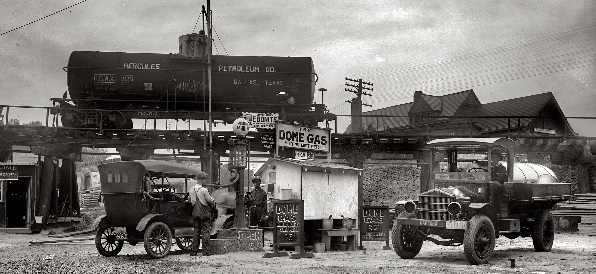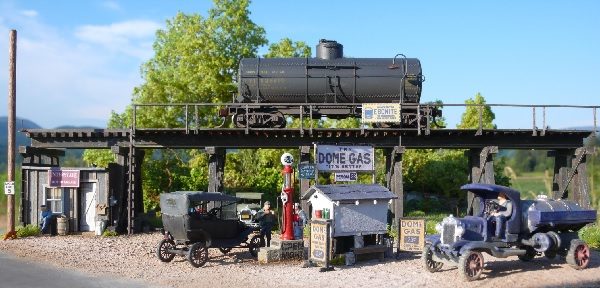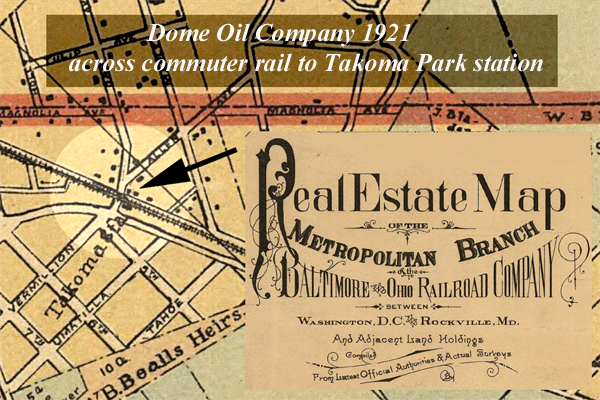A Library of Congress photo tells many early automobile tales.
Picturing history, images in the Library of Congress digital collection offer rare insights into the early U.S. petroleum industry.
Details found in just one 1921 black-and-white photograph of a Washington, D.C., suburb capture a scene of petroleum products and transportation infrastructure two decades after the first U.S. auto show. Originally printed from an eight-inch by six-inch glass negative, the Library of Congress image features Takoma Park, Maryland, and its railroad station on the northeastern border of the District of Columbia.

Despite “blemishes resulting from a natural deterioration in the original coatings,” this 1921 image of a Takoma Park, Maryland, gas station from the Library of Congress Prints and Photographs Division helps preserve U.S. petroleum history.
Today a quiet residential community, Takoma Park was established in 1883 by New York venture capitalist B.F. Gilbert and was among the first railroad-accessible suburbs to downtown D.C.
“Takoma ‘s development followed a prototypical pattern for similar real estate ventures throughout the United States in the late 1800s and early 1900s,” explained local historian Lisa Bently in 1999.
“The little community was promoted as offering healthy living (it occupies land several hundred feet higher than the lowlands of downtown Washington), fresh air, and uncrowded living conditions,” she added.

A model railroad enthusiast’s scale model of petroleum technologies in action, details recreated from the the Library of Congress photo of the Dome Gas Station at Takoma Park in 1921.
However, unlike many other Victorian-era commuter rail suburbs, Takoma Park’s location on a major rail line — the Baltimore and Ohio Railroad (B&O) — creating a thriving commercial district, Bently noted in her paper, “Historic Significance of Takoma Park”.
According to Arcadia Publishing’s 2011 book Takoma Park, Images of America, the Dome Oil Company was established by Ernest C. Ruebsam and Harry Stevens.

Illustration of where Dome Gas Station was located in Takoma Park, Maryland. The Baltimore and Ohio Railroad (B&O) station at Takoma Park created a thriving commercial district for the D.C. suburb.
The filling station on the B&O railway was among the first in D.C. to offer fuel oil as an alternative to coal as well as gasoline, which was then at 40 octane to 60 octane. The higher the octane, the higher compression the fuel can withstand before detonating (also see Ethyl Anti-Knock Gas).
Oil History in One Photo
A closer look at the Library of Congress photograph (catalog no. 94507465), “Dome gas service station, Takoma Park, Md.”
By 1893, the B&O station at Takoma Park offered commuter service to downtown D.C. for 20 cents. The station, which was destroyed by fire in 1961, can be seen in the background of the 1921 photo.
On the nearer side of the tracks, Dome Gas Company’s filling station once serviced customers with “Better Quality – Same Price” gasoline selling for 23 cents a gallon.
The pictured Dome Gas station’s gasoline pump featured a glass reservoir, introduced by the Tokheim Company in 1906 and instantly popular with consumers (learn more in First Gas Pump and Service Station).
The pump in the photo appears to be a model manufactured by Fleckenstein Visible Gasometer Company, founded in 1916 by Jackson Fleckenstein, who was just 19 years old when he started his Grand Rapids, Michigan, pump company.

Garford Motor Truck Company manufactured fuel oil trucks in addition to earning a reputation for reliability by providing trucks for the United States Postal Service.
In the absence of underground storage tanks at the time, railroad tank cars like that of Hercules Petroleum Company pictured were often used as temporary storage. Hercules Petroleum of West Dallas, Texas, had a controversial association with Ajax Oil Company, including Hercules Petroleum stock sales being manipulated by sales agents of Farson, Son & Company.
John Farson was indicted in 1924 and Hercules Petroleum went bankrupt not long afterward.
More Oil History
The photograph’s small sign on the railway trestle preserves the memory of a now forgotten lubricant once available in five pound cans. “Ebonite” was a grease that boasted “no animal fat nor any other harmful ingredients.” It also could be purchased in 25-pound cans for customers’ convenience.
According to the company, Ebonite’s exclusive refining process formed minute strings unlike any other transmission lubricants. It was produced by the Bayerson Oil Works of Erie, Pennsylvania. Advertisements proclaimed “Strings Cling Better Than Globules.”
The photo’s early fuel oil truck was manufactured by the Garford Motor Truck Company, whose reputation for reliability had been proven when the United States Postal Service contracted for 31 Garford vehicles in 1912. The company later became Superior Body Company, associated with Studebaker Company, and was known for its school buses before closing down in 1980.
Takoma Park would earn a reputation as “Azalea City” because one of its early residents was Benjamin Morrison, a pioneer in horticulture who served as the first director of the U.S. National Arboretum. Morrison developed hybrid azaleas still found throughout the community.
Dome Oil Company co-founder Ernest Ruebsam, who had left Takoma Park by 1931, was arrested in Louisiana after an automobile accident where it was discovered he was transporting 18 gallons of alcohol, a violation of the National Prohibition Act.
The LOC digital image of the gas station at Takoma Park is from the photographic files of the National Photo Company, which covered current news events in Washington, D.C., as a daily service to its subscribers during the administrations of Presidents Wilson, Harding, Coolidge, and Hoover (1919-1932).
Acquired by LOC in 1947 from company proprietor Herbert E. French, a small selection of an estimated 80,000 photographic prints were available online in 2018.
_______________________
Recommended Reading: Takoma Park, Images of America (2011); An Illustrated Guide to Gas Pumps (2008); Fill’er Up!: The Great American Gas Station
(2013). Your Amazon purchase benefits the American Oil & Gas Historical Society. As an Amazon Associate, AOGHS earns a commission from qualifying purchases.
_______________________
The American Oil & Gas Historical Society (AOGHS) preserves U.S. petroleum history. Become an AOGHS annual supporting member and help maintain this energy education website and expand historical research. For more information, contact bawells@aoghs.org. © 2024 Bruce A. Wells. All rights reserved.
Citation Information – Article Title: “Dome Gas Station at Takoma Park.” Authors: B.A. Wells and K.L. Wells. Website Name: American Oil & Gas Historical Society. URL: https://aoghs.org/transportation/oil-companies-gas-stations-maryland. Last Updated: January 2, 2024. Original Published Date: April 13, 2018.


